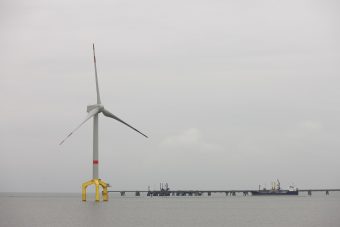
The UK’s offshore wind sector has enjoyed a bumper year according to new data, with the total value of construction projects in 2016 hitting £4.1bn, up from just £2.45bn a year earlier.
New figures released yesterday from construction industry analysts Barbour ABI indicate offshore wind farms accounted for 42 per cent of total construction value for the utilities and power sector, and a fifth of the country’s entire infrastructure sector, in 2016.
“Back in 2013 offshore windfarms accounted for only 7.5 per cent of the annual construction value for the utilities and power sector, which increased to 42 per cent in 2016, on the back of significant investment in this type of project,” Michael Dall, lead economist at Barbour ABI, said in a statement. “With reports showing that the cost of producing electricity in this way have fallen significantly, the increase in construction value makes sense.”
The 2016 figures were boosted by progress on three major offshore wind projects: the Beatrice, Galloper and East Anglia One offshore wind farms, which together were worth more than £3bn in construction value over the course of the year.
According to Barbour ABI, the sector is set to continue to grow into 2017, with £23.2bn of construction contract value in the pipeline from offshore farms which have been awarded planning permission.
“We have also seen a large uptake in the planning pipeline for future offshore windfarms with £23.2bn worth of construction planned over the coming years, suggesting this burgeoning sector will continue to expand in 2017 and beyond,” Dall added.
However, the £23.2bn figure is driven by just 11 major offshore wind projects, including the Dogger Bank and Hornsea offshore projects, and industry experts fear the pipeline for new projects will slow to a trickle beyond 2020 without fresh moves by government.
Analysis of government data published last month by the environmental think tank Green Alliance suggests UK investment in renewables is set to plummet by up to 95 per centwithout a decision to clarify post-2020 clean energy support mechanisms such as the future of the Contracts for Difference scheme, which has proved crucial for bringing new offshore wind projects on stream.
In related news, the Dutch Parliament urged the government to add another offshore wind farm zone to current development plans, opening the door for additional offshore wind capacity to be deployed in the next five years.
The vote calls on government to investigate the potential for developing an additional farm by 2023, in addition to projects already in the pipeline.
The Netherlands currently aims to have 4.5GW of offshore wind capacity installed by 2023, and is considering a new 30 per cent renewable energy target by 2030.
Source: businessgreen.com



